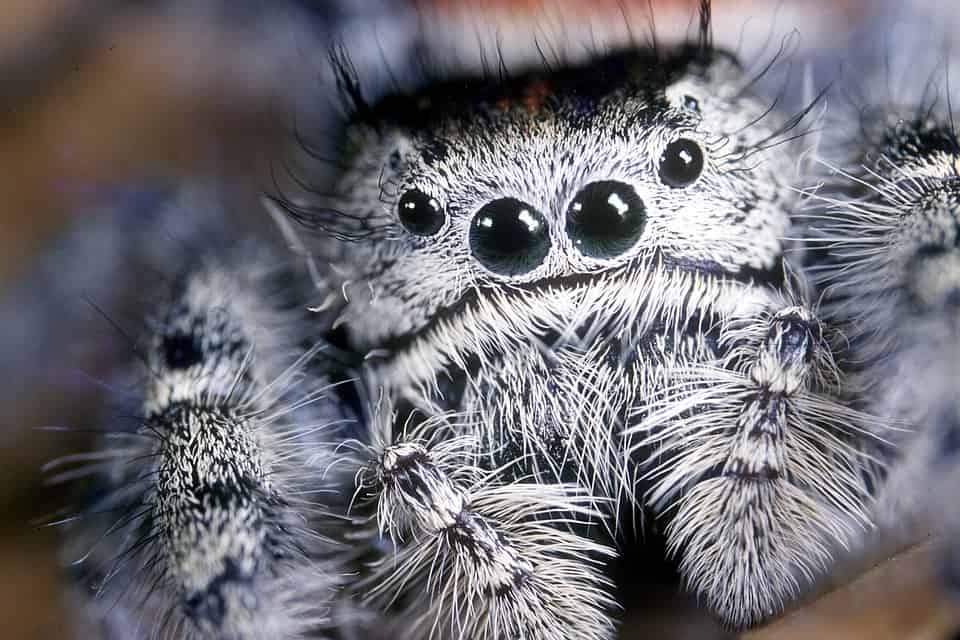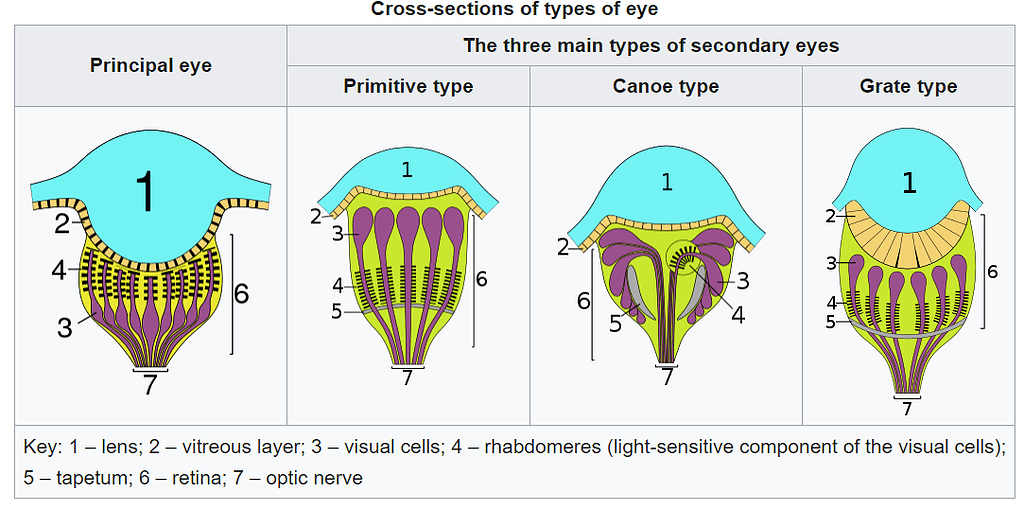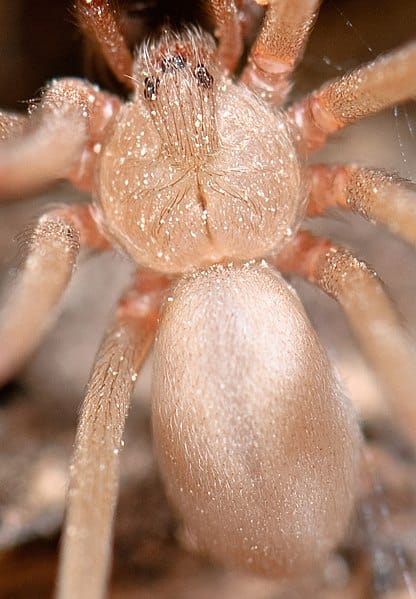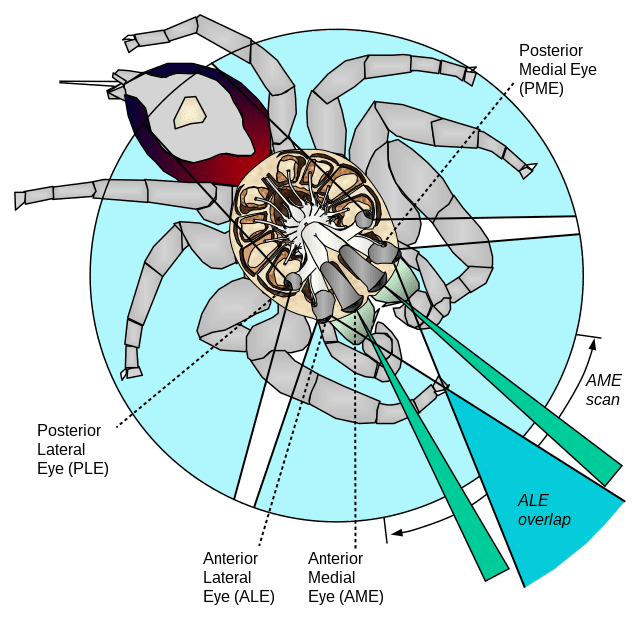
Spiders are a fascinating group of animals, with over 45,000 known species worldwide. They are found in almost every environment and exhibit striking adaptations to their environment. One of the most distinctive features of spiders is their eyes.
Spiders have more eyes than you or me, but how many? We learn as kids that all spiders have eight eyes, but the reality is that the number and arrangement of eyes vary between species.
While the majority of species have eight eyes, there are some more unusual species with six eyes. Some spiders have two eyes, some spiders have four, and some have none. But there’s far more to arachnid vision than meets the eye.
- the vast majority of spiders have 8 eyes;
- having more eyes helps them detect predators fasters and assess depth;
- some spiders have six, four, two, or zero eyes — but always in pairs;
- despite these eyes, most spiders don’t really see all that well.
Spider vision
To understand spider eyes, we first need to clear out one thing: spiders are not insects. Sure, they have some similarities at first glance, but spiders are part of a group of animals called arachnids. And arachnids and insects have very different types of eyes.
The majority of spider species have eight eyes, each being a simple eye with a single lens. Meanwhile, many insects have compound eyes, which can consist of thousands of small independent visual units.
Spiders’ eyes are simple and often called ocelli (one eye is called an ocellus). They’re called as such because they have a single lens above a simple retina.
Most spiders don’t really see all that well. In fact, most species can detect brightness or motion, but not much more. However, other species, like jumping spiders, for instance, have excellent vision and developed eyes. That’s because jumping spiders are active predators (like lions, for instance), and go around hunting their prey, but most spiders don’t do that and don’t really need good vision.
So if spiders don’t usually see all that well why do they have so many eyes?
Spiders Usually Have 8 Eyes. But Why?

Most spiders have 8 eyes which are arranged in two rows of four. Some eyes are bigger, while others are smaller (but we’ll get to that in a bit). Like other things in our bodies, eyes are a product of evolution, so spiders must have a reason or two for having 8 eyes. The first reason comes from the neck — or rather, the lack of one.
Spiders don’t have necks, which means they can’t turn their head around. Having extra eyes around the head means you can spot predators easier and faster getting away from threats.
Spiders, or at least some spiders, use their multiple eyes for depth perception. They can’t use parallax, like humans do, to perceive depth, so instead they use a trick that defocuses their vision to assess depth.
Perhaps the most important reason why spiders have so many eyes, however, is that their eyes do different things.
Not all spider eyes are the same
For the spiders which have eight eyes (which make up over 90% of all species), the eyes are typically arranged into two rows of four eyes. They are often categorized by their position.

The anterior median eyes, which are located in the middle of the spider’s head, are typically the largest and most sensitive of the eight eyes. These eyes provide the spider with depth perception and the ability to track and capture prey.
The other six eyes are arranged around the anterior median eyes and are generally smaller and less sensitive. These eyes provide the spider with a wider field of vision, enabling them to detect potential predators and other threats from a greater distance. For some spiders (in particular, jumping spiders), eyes on the side of the head also help them perceive prey, something called the “looming response.”
Remember when we said spiders are specialized to their environment? Their eyes also follow the adaptations. Some spiders called net-casting spiders, have two large eyes toward the rear of their heads that are used for night vision. These eyes are large to gather as much light as possible and also enable a wide field of vision.
Spider eyes can also be categorized by structure into the principal eyes (or main eyes), which are always the anterior median eye (AME), and the secondary eyes, which are always the posterior median eye (PME), anterior lateral eye (ALE), and posterior lateral eye (PLE).

The position and size of the eyes can vary among different species of spiders. For example, jumping spiders have relatively large eyes that allow them to track and catch prey with incredible precision, while orb-weaving spiders have smaller eyes that are better suited for detecting the movement of their webs. Then again, some spiders have none.
Some Spiders Have 6 Eyes, some have none
While the majority of spider species have eight eyes, there are some exceptions. For example, the brown recluse spider (Loxosceles reclusa), which is found in parts of North America, has only six eyes, arranged in three pairs.
The brown recluse spider (Loxosceles reclusa) is part of a group called Sicariidae, and all members of this group have six spiders, arranged into three pairs. They’re not the only group with this characteristic. The so-called spitting spiders, which have been around since the Cretaceous, also have six eyes, as do some of the cellar spiders.
If you’re wondering, the eyes that are missing are the big, principal eyes — a testament to how spiders can manage with poor vision.

It gets a bit weirder with Symphytognathidae, a group of spiders that have “only” four eyes. These are also some of the smallest spiders in the world (the smallest according to some estimates), but it’s not clear whether their size has anything to do with the number of their eyes. Some spiders in the scaffold web spider family also have four eyes
Another group of small and unusual spiders is the Caponiidae, a group that was discovered relatively recently. Most spiders in this group only have two eyes.
Lastly, some spiders have only vestigial or no eyes. This is a different type of adaptation and appears pretty much only in spiders living underground or in caves, where there’s no natural light. Several spiders with no eyes have been discovered. In this type of environment, spiders can’t get much use out of their eyes, so evolution simply starts phasing them out.
Do Spiders Have Good Vision?
The question of whether spiders have good vision is a complicated one. While spiders are not known for their visual acuity, some of them do have some impressive visual abilities.
One of the most remarkable examples is the jumping spider, which has been described as having “the best vision of any known arthropod.” Jumping spiders have four large eyes that can move independently, giving them a large field of vision.
It also depends on what you mean by “good vision” — if you mean seeing accurately what’s in front of them, most spiders don’t have good vision. But they can see around themselves more than you or I, and that’s also an asset, especially if you’re always on the lookout for prey and threats.

A lesson in biology
We tend to clump up spiders in a single group, but they are so diverse and so remarkably well-adapted that they can exhibit striking differences. After all, the number of eyes a spider can have ranges from 0 to 8, so that alone is proof of how diverse the group is.
Both the number and arrangement of eyes in spiders vary significantly between species. While the majority of spider species have eight eyes (90-99% of them), some, such as the brown recluse spider, have only six. Others have four or two, and spiders that live without natural light can give up their eyes entirely.
The study of spider eyes and vision is a fascinating area of research that received little attention until recently. New research continues to reveal stunning insights into the natural world of spiders. By understanding the unique features of spider eyes, we can gain a greater appreciation for these remarkable creatures and the important role they play in the ecosystem — and not just be spooked out about them.


